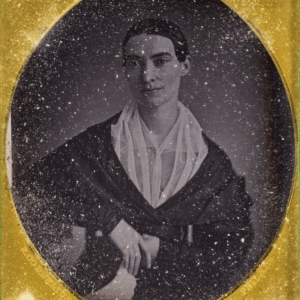JTF (just the facts): Published by Aperture in 2024 (here). Softcover with dust jacket (17 x 22.5 cm), 124 pages, with 80 color and black-and-white reproductions. Includes a conversation between the artist and Audrey Sands, texts by Kao Kalia Yang, Godfre Leung, and Kong Pheng Pha, and a poem by Mai Der Vang. Design by Studio Lin. (Cover and spread shots below.)
Comments/Context: The work of Pao Houa Her, an artist and educator originally from Laos and now based in Minnesota, stems from her family history, and her people’s stories of displacement and of longing for home. Her was born in Laos but her parents (members of the indigenous Hmong ethnic group) left the country shortly after, staying in three different refugee camps before finding their new home in the United States. In her photographs, Her uses portraiture and landscape imagery to explore notions of home and family and to reimagine Hmong culture. She was a 2023 Guggenheim Fellow, and she also won the 2023 Aperture–Baxter Street Next Step Award, leading to the publication of her first monograph and a solo show at the Camera Club of New York earlier this spring (here, installation shots above). Titled My grandfather turned into a tiger … and other illusions, the photobook brings together Her’s photographs made over the past decade.
Her’s work is highly conceptual, and mostly staged, mixing the real and the artificial. The artist’s grandfather died as a soldier during the Vietnam War, and she largely knows him through the stories told by her family members. According to one of them, shortly after his death a tiger appeared at the home of her grandmother, who recognised the animal as a reincarnation of her husband. Her says, “I don’t think of photography as just memory. For me photography is never real. It’s fiction. <…> So maybe it’s not that photography is fiction, but photography is selected memory.” Many of the motifs in Her’s work are symbolic, offering insight into the photographer’s life story, yet going well beyond just the private sphere.
My grandfather turned into a tiger is a medium size book of comfortable size. A portrait of Pao Sao, one of the grandchildren, appears on the cover, overlaid over a blurred landscape (there are 32 different variations of the landscape image generated using AI) on its vinyl dust jacket. Inside, the photographs vary in their size and arrangements creating a dynamic and unpredictable visual flow. The accompanying essays appear at the very end of the book and are intentionally printed in bright colors on glossy paper. These hot pinks, purples, and blues pay homage to the colors in Hmong traditional clothing. The texts provide insight into family history, the Hmong identity, and Her’s artistic practice. The captions appear as a simple list paired with a foldout spread that includes thumbnails, for easy reference.
The photobook weaves together six of Her’s major series, creating an exciting non-linear visual narrative. The title work reimagines her family’s history before leaving Laos. Formal portraits of Hmong American veterans who were recruited by the US government to fight during the Vietnam War and never officially recognized as veterans are part of the “Attention” (2012-2014) series. In the series titled “My Mother’s Flowers” (2016), the artist pairs studio shots of her mother’s collection of silk flowers with profile pictures that Hmong women use on dating sites. In “After the Fall of Hmong Tebchaw”, Her photographed Hmong-American elders who were conned into investing large sums of money towards a fraudulent scheme that promised a new Hmong homeland. In these portraits elderly Hmong women are captured with dignity against traditional backdrops of artificial flowers referencing the lush Laosian landscape. “The Imaginative Landscape” (2018-2020) explores the fraudulent relationship between the Hmong diaspora and the idea of home, while the most recent work “Mount Shasta” (2021-2022) depicts landscapes related to marijuana farming by Hmong migrants, exploring migration, labor, and agriculture. Floral motifs recur in all of these projects, tying the layered visual flow together.
The book opens with a vertical image taken over by flowers covering an erect penis. The photo is titled Flower penis (2017) and presented as a lenticular print in the exhibition. It is followed by a black-and-white landscape with weathered trees and tangled cords from the series of marijuana farmers (to conceal their identity, the series has no people). Evoking the opium cultivation in Laos, for many Hmong this is the closest thing they have to Laos. Her uses flora and landscape in general as both a camouflage and a portal.
Another spread pairs two portraits of veterans, both shot against a velvet drape. Their uniforms are decorated with medals (the veterans buy their own uniforms and their own medals) and dignified postures aim to pay tribute and restore history, while the reference to “Hmong veteran” in the caption instead of their names emphasizes their current anonymous standing with the US Army. In another black and white photo titled Rest stop in Laos (2017), a scene of four young men taking a selfie outside becomes a subject in itself in Her’s photograph.
A photograph of a tiger in the jungle is placed right in the center of the book, and it takes a moment to realize that the image is created by overlaying several photos. Meanwhile, another photograph portrays two women in traditional dresses in front of a lush floral backdrop, yet a cell phone held by one of them disrupts the illusion of the photo.
The various series in this survey photobook bring together connections between Her’s family, the Hmong diaspora, and the consistent desire for home, mapping out a wider and more nuanced story. My grandfather turned into a tiger is a complex layered portrait of life in the diaspora, touching upon intergenerational traumas and longing for recognition and belonging. And while a tangible homeland may not exist, Her applies inventive artistic approaches to articulate a sense of home.
Collector’s POV: Pao Houa Her is represented by Bockley Gallery in Minneapolis (here). Her work has little secondary market history, so gallery retail likely remains the best option for those collectors interested in following up.




























